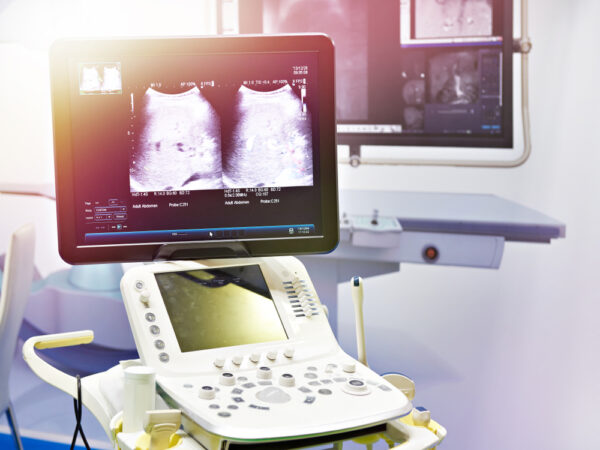Ultrasound Quality Control and Testing

The superior level of healthcare we’re capable of delivering to patients is due, in large part, to the equipment we use to administer it.
That equipment is only as good as its maintenance — especially the delicate instrumentation of diagnostic equipment, which needs regular care and upkeep to continue delivering results with integrity.
As ultrasound increasingly moves to the forefront of healthcare technology, it’s critical that equipment managers pay keen attention to quality control and ultrasound testing. Let’s take a look at some of the best practices companies like Acertara use to keep delicate, sensitive instrumentation operating perfectly.
The role of quality control and testing
Ultrasound quality control (QC) is a systematic process of evaluating and documenting the performance of ultrasound equipment. QC testing quantifies and verifies the accuracy and reliability of ultrasound images, which ensures the tech operates within acceptable limits.
Regular ultrasound system QC and maintenance are crucial — without it, delicate instrumentation is likely to become less effective. That can result in artifacts on images, electrical leakage in probes, weaker signal strength during scans, and a host of other issues. These problems make a diagnostician’s job more difficult, put patient diagnoses at risk, and cast doubt on the efficacy of information.
On the other hand, well-maintained probes that are inspected and calibrated to established industry standards give clinicians better scan integrity and more reliable equipment, among other benefits.
Quality control standards
Ultrasound equipment is sensitive, so inspection, maintenance, calibration, and repair should all be conducted by specialists. A partner like Acertara can service sensitive equipment properly, and we make sure the entire process follows critical quality control standards, including:
- Regularly scheduled ultrasound testing. QC tests should be performed on a regular schedule, according to the manufacturer’s recommendations. This helps identify potential problems early on, before they can affect patient care.
- Use of phantoms. Phantoms are specially designed objects that are used to test the performance of ultrasound equipment. Phantoms can assess a wide range of parameters, including image quality, depth of penetration, and spatial resolution.
- Personnel training. The technicians who perform QC testing should be properly trained in the procedures and techniques involved. This ensures all the tests and calibrations are performed correctly and the results are accurate.
- The results of QC testing should be documented clearly and concisely. And because documentation tracks the performance of the equipment over time, it uncovers issues before they become problems.
Ultrasound testing best practices
Certain quality control measures are essential within the parameters of these best practices. Ultrasound technicians will run a battery of tests and checks to make sure equipment is properly assessed against benchmarked standards. Some of these QC tests include:
- Image quality. This test assesses the overall quality of the images produced by the ultrasound. It typically involves looking at a phantom and evaluating the sharpness, contrast, and brightness of the images.
- Depth of penetration. This test determines the maximum depth at which the ultrasound equipment can produce images. It’s important to ensure the equipment is capable of imaging structures at the depth required for the specific clinical application.
- Spatial resolution. This test measures the ability of the ultrasound waves to distinguish two closely spaced objects. Sufficient spatial resolution is a critical factor in producing clear images of the structures of interest.
In addition to these specific tests, ultrasound quality control programs include general inspections of the equipment for damage or wear. Typically, technicians also thoroughly clean and disinfect equipment to prevent the spread of infection.

Who sets the standard?
Quality control best practices ensure ultrasound equipment operates at peak performance so that patients receive the highest quality of care. And these best practices aren’t mere suggestions — they’re industry standards. Some of the most comprehensive standards include:
- IEC 60601. This series of standards specifies safety and performance requirements for medical electrical equipment, including ultrasound systems.
- AIUM Practice Guidelines. The American Institute of Ultrasound in Medicine (AIUM) publishes practice guidelines covering various aspects of ultrasound, including equipment maintenance, quality control, and safety.
- ISO 13485. This international standard outlines the requirements for a comprehensive quality management system for medical device manufacturers, which plays a role in defining maintenance standards for ultrasound systems.
And, of course, manufacturers’ recommendations must be factored in as well. Their user manuals, technical documentation, and maintenance guides provide detailed instructions for the proper care, cleaning, and maintenance of ultrasound systems.
Quality control is critical
From obstetrics to oncology, ultrasound is ubiquitous in healthcare. With so much riding on the integrity of diagnostic equipment, proper maintenance, calibration, repair, and upkeep are paramount. That QC allows us to continue providing the superior level of healthcare patients expect — and sustains our confidence in the equipment we use to administer it.
And it all starts with the right ultrasound service partner.

